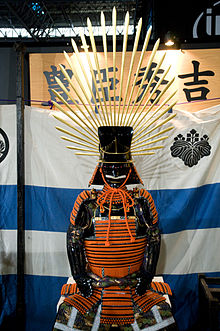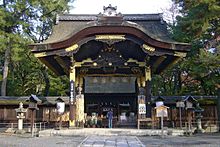Toyotomi Hideyoshi
Toyotomi Hideyoshi ( Japanese 豊 臣 秀吉 ; * March 17, 1537 in Nakamura, Aichi-gun , Owari Province (today Nakamura-ku , Nagoya ); † September 18, 1598 at Fushimi Castle (today in Fushimi-ku , Kyōto )) was a Japanese general and politician who made a decisive contribution to the unification of modern Japan (also referred to as the second of the three unions ). He took office as general after the assassination of Oda Nobunaga , brought about the unification of Japan and was replaced by Tokugawa Ieyasu , who founded the Tokugawa dynasty of the shoguns .
Life
Hideyoshi was born as the first son of a farmer in the village of Nakamura (now a municipality of Nagoya) in Owari Province . His first name was Hiyoshi or Hiyoshimaru . His striking physiognomy earned him the nickname Saru ( monkey ). Hideyoshi's father Yaemon († 1543 ) had fought as a simple foot soldier in the army of Oda Nobuhide and was certainly not a member of the samurai class . However, the family was demonstrably prosperous and owned a plot of land of its own. As a young man, Hideyoshi first served the Matsudaira family, who were vassals of the Imagawa , in the Mikawa province . In 1558 he left the Imagawa to enter the service of Oda Nobunaga. In 1560 Hideyoshi fought for the Oda at the Battle of Okehazama . He started his career as a simple soldier, but with some success he rose to higher ranks. On the battlefield, he could be recognized by the impressive deer antlers on his helmet. He called himself Kinoshita Tōkichirō ( 木 下 藤 吉 郎 ) and married Nene (or One). During that time he met Maeda Inuchiyo , with whom he became friends.
Hideyoshi showed strategic and tactical talent on the battlefield and possessed an extraordinarily high diplomatic skill (he worked his way up from a foot soldier to the most powerful man in the empire). After he was successful in the war against the Asai and Asakura in the provinces Ōmi and Echizen , Oda Nobunaga raised him in 1573 to the daimyō of Nagahama in Sudomi. Tōkichirō changed his name and called himself from now on Hashiba Hideyoshi ( 羽 柴 秀吉 ), which probably went back to the initiative of two of Nobunaga's most well-off men: Niwa Nagahide and Shibata Katsuie .
When Nobunaga fell victim to an attack by his follower General Akechi Mitsuhide in Kyoto on June 21, 1582 , Hideyoshi was on his behalf on the way to a campaign against the Mōri family in Chūgoku . Hideyoshi immediately turned around with his men in the province of Bitchu and defeated the Akechi (Mitsuhide and his cousin Mitsuharu, who was forced to follow him) thirteen days after Oda Nobunaga's death in the battle of Yamazaki off Kyoto. With this victory, his political influence grew, and so he demanded that Samboshi, Nobunaga's grandson and the only son of Nobunaga's first son, should inherit his grandfather. With this decision he de facto became Oda Nobunaga's successor and asserted himself against the opposition of Nobunaga's second and third sons as well as some other influential men of the empire. In 1583 he built Osaka Castle (Naniwa), in the Settsu Province , to rule over Japan from there.
Occasionally it is discussed in Japanese literature that, contrary to popular opinion, Hideyoshi was not denied the office of Shogun because of his low origin. This rumor was spread by observers at the time, for whom this office was the ultimate declaration of rule. In doing so, they disregarded the fact that both the office of Shogun and that of Kampaku - which Hideyoshi occupied in 1585 - were always occupied by members of the imperial second families. Hideyoshi chose the office of Kampaku instead, because he wanted to see himself connected to the immortal glory of the court and not to the pathetic end of the Ashikaga shogunate.


In 1586 Hideyoshi finally chose his new clan name ( uji ) Toyotomi , the "Generous Minister", in consultation with the emperor , with which his name was actually Toyotomi no Hideyoshi . When he was able to defeat the Hōjō clan in Odawara in the Kantō region in 1590 , he had secured his rule over Japan. In 1591 he gave up his Kampaku seat in favor of his nephew, Toyotomi Hidetsugu , but continued to be known as taikō and de facto ruler of all of Japan.
Initially Hideyoshi continued Nobunaga's pro-Jesuit policy. He later issued an edict of deportation for the missionaries (1597), which was repealed after his death and was only enforced consistently under his successors, the Tokugawa shoguns, from 1614 onwards. Many missionaries also stayed in Japan and continued their missionary work undercover or returned after Hideyoshi's death. According to a report by the world traveler Francesco Carletti , who was in Japan at the time, the main reason for the deportation was an incident in 1596. At that time, a Spanish ship laden with heavy cargo, coming from Manila with a broken rudder, ran aground on the Japanese coast. According to Hideyoshi's decree, all cargo on a stranded ship belonged to the Japanese state and was confiscated.
The Spaniards tried to circumvent this law by claiming and the missionaries that the summons belonged to the Franciscan Order, which had been proselytizing in Japan since 1593 . Hideyoshi's answer was, “How is it possible that these monks who claim to be so poor are now saying that that shipload is theirs? So I think that they must be very bad deceitful people. I have also ordered that their outrageous religion be banned. ” As a direct result of this incident, six Franciscan brothers and twenty Japanese converts were crucified in Nagasaki in February 1597 and all churches in Japan were closed.
Hideyoshi legally separated the samurai from the peasant class. The farmers were no longer allowed to leave their place of residence and own weapons. Hideyoshi's troops marched through the country collecting the farmers' weapons. This process is known as sword hunting. A huge Buddha statue was to be cast from the metal of the melted down weapons to protect the Japanese people.
Hideyoshi also wanted to rule Korea and the Chinese Empire , which the daimyo opposed. Contrary to the advice of the daimyo, he moved to Korea in the Imjin War in 1592/93 . At first he succeeded in bringing almost all of Korea under his control. But when the Chinese Ming emperor Wanli entered the war at the side of his Korean vassal, the Japanese suffered heavy losses. In addition, the Koreans, with the help of their admiral Yi Sun-sin, destroyed the Japanese supply fleet, which significantly hampered Hideyoshi's invasion plans.
A second attempt at invasion in 1597/98 also failed. Relations with Korea remained at zero until 1607. Toyotomi Hideyoshi died in 1598 in Fushimi Castle near Kyoto (today a district of Kyoto). On his deathbed, he asked the five daimyos to take care of his son Hideyori , the heir of Japan.
Hideyoshi's goals to create a dynasty and unite the empire, however, failed. Tokugawa Ieyasu , one of the five daimyōs he appointed to the Council of Five Regents , eliminated his competitors one by one, unified the empire and finally secured his rule at the Battle of Sekigahara . Hideyoshi's descendants were killed.
In the Zen Buddhist tradition, Hideyoshi wrote the following death poem on his deathbed, shaped by the Buddhist idea of the transience of the world , in which he compared his life with a dream in a dream:
「露 と 落 ち 露 と 消 え に し 我 が 身 か な 難 波 の こ こ も 夢 夢 の ま た 夢」
"Tsuyu to ochi / tsuyu to kiye ni shi / waga mi kana / Naniwa no koto mo / yume no mata yume"
"I am like the falling and waning dew! Even the Osaka Castle is only a dream within a dream. "
Shinto
Hideyoshi was posthumously worshiped under the name Toyokuni Daimyōjin (豊 国 大 明 神 "shining deity of the country's wealth"). As a Shinto deity ( Kami ), he is worshiped in a number of shrines . These are called either Toyokuni Shrine ( Kun Reading ) or Hōkoku Shrine (On Reading), both can be written 豊 国 神社 ( Shinjitai ) or 豐 國 神社 ( Kyūjitai ), including the Toyokuni Shrine in Kyōto (built in 1599 ), later rebuilt as Hokoku Shrine (built in 1700 at the current location of the Hokoku-ryo mausoleum, then demolished and rebuilt in another location in 1880), the Toyokuni Shrine in Kanazawa, the Hokoku Shrine in Tokkyō, the Hokoku- Shrine in Osaka (together with Toyotomi Hidenaga and Toyotomi Hideyori), the Nagoya Toyokuni Shrine (built in 1881) and the Nagahama Hokoku Shrine (Shiga Prefecture).
Cinematic reception
The Japanese film The Death of a Tea Master deals with the conflict between Hideyoshi and his influential tea master Sen no Rikyu . The documentary The Gold of the Samurai also deals with Hideyoshi Toyotomi. The film is mainly about the extraction and use of the gold he mined. In the fantasy film The Legend Of Goemon by director Kazuaki Kiriya , in addition to Hideyoshi himself, his tea master Rikyu and his predecessor Oda Nobunaga as well as his successor Tokugawa Ieyasu appear.
literature
- Eiji Yoshikawa : Taiko. A. Knaus Verlag, Munich, 1993, ISBN 3-8135-0303-8
Web links
- Short biography on samurai-archives.com (English)
Individual evidence
- ↑ Stephen Tunbull: Toyotomi Hideyoshi, Oxford 2010, p. 6.
- ↑ Turnbull 2010, p. 9.
- ↑ Simone Müller: Longing for Illusion? Classic Japanese dream poetry from a literary historical and gender perspective . Peter Lang, Bern 2005, ISBN 3-03910-478-0 , p. 39 ( limited preview in Google Book search).
| personal data | |
|---|---|
| SURNAME | Toyotomi, Hideyoshi |
| ALTERNATIVE NAMES | 豊 臣 秀吉 (Japanese) |
| BRIEF DESCRIPTION | Japanese general and politician |
| DATE OF BIRTH | March 17, 1537 |
| PLACE OF BIRTH | Nakamura, Aichi-gun, Owari Province (now Nakamura-ku, Nagoya) |
| DATE OF DEATH | September 18, 1598 |
| Place of death | Fushimi Castle (today in Fushimi-ku, Kyōto) |


